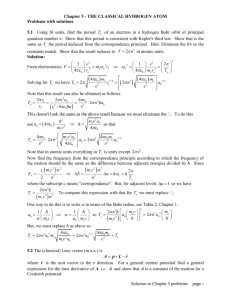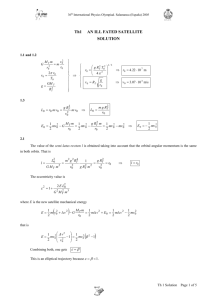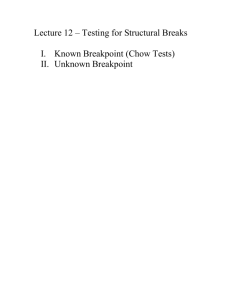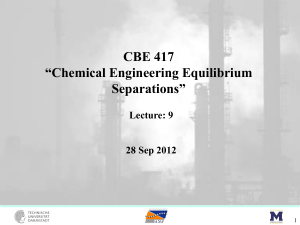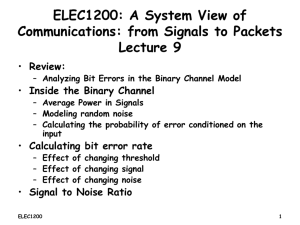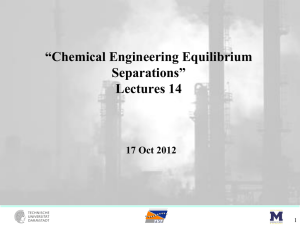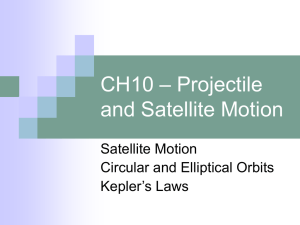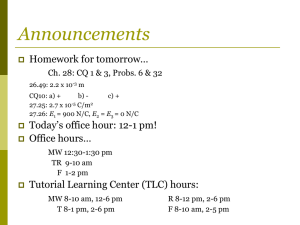Possible Orbits for Inverse Square Law Force
advertisement
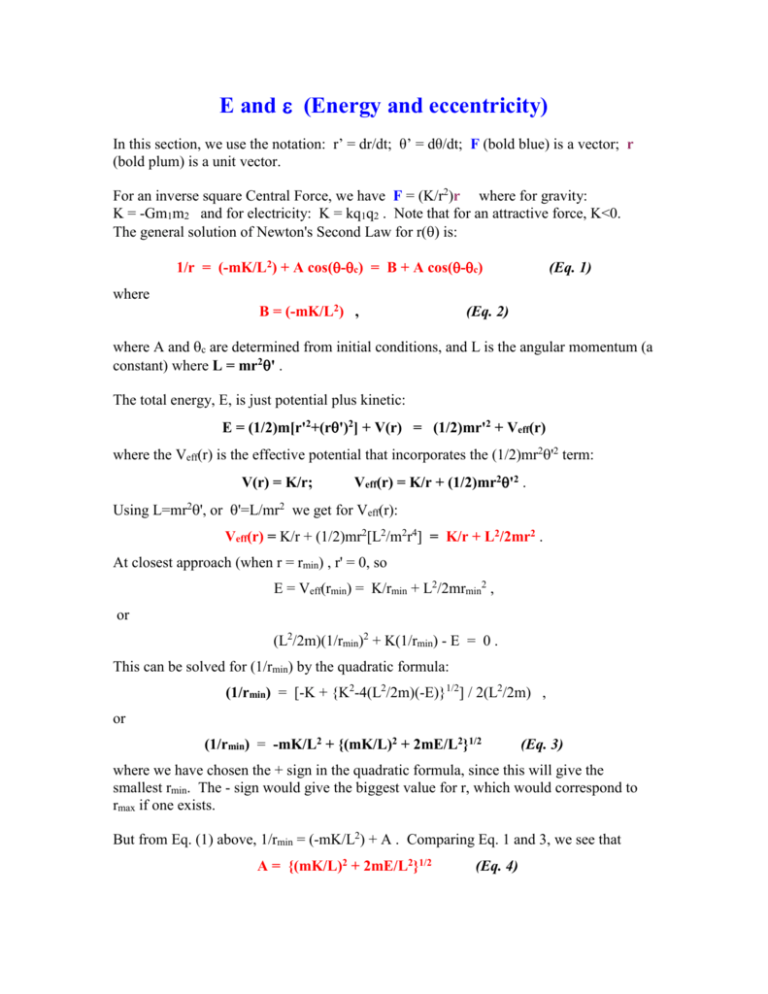
E and (Energy and eccentricity)
In this section, we use the notation: r’ = dr/dt; θ’ = dθ/dt; F (bold blue) is a vector; r
(bold plum) is a unit vector.
For an inverse square Central Force, we have F = (K/r2)r where for gravity:
K = -Gm1m2 and for electricity: K = kq1q2 . Note that for an attractive force, K<0.
The general solution of Newton's Second Law for r() is:
1/r = (-mK/L2) + A cos(-c) = B + A cos(-c)
(Eq. 1)
where
B = (-mK/L2) ,
(Eq. 2)
where A and c are determined from initial conditions, and L is the angular momentum (a
constant) where L = mr2' .
The total energy, E, is just potential plus kinetic:
E = (1/2)m[r'2+(r')2] + V(r) = (1/2)mr'2 + Veff(r)
where the Veff(r) is the effective potential that incorporates the (1/2)mr2'2 term:
V(r) = K/r;
Veff(r) = K/r + (1/2)mr2'2 .
Using L=mr2', or '=L/mr2 we get for Veff(r):
Veff(r) = K/r + (1/2)mr2[L2/m2r4] = K/r + L2/2mr2 .
At closest approach (when r = rmin) , r' = 0, so
E = Veff(rmin) = K/rmin + L2/2mrmin2 ,
or
(L2/2m)(1/rmin)2 + K(1/rmin) - E = 0 .
This can be solved for (1/rmin) by the quadratic formula:
(1/rmin) = [-K + {K2-4(L2/2m)(-E)}1/2] / 2(L2/2m) ,
or
(1/rmin) = -mK/L2 + {(mK/L)2 + 2mE/L2}1/2
(Eq. 3)
where we have chosen the + sign in the quadratic formula, since this will give the
smallest rmin. The - sign would give the biggest value for r, which would correspond to
rmax if one exists.
But from Eq. (1) above, 1/rmin = (-mK/L2) + A . Comparing Eq. 1 and 3, we see that
A = {(mK/L)2 + 2mE/L2}1/2
(Eq. 4)
We now define as (with B = -mK/L2):
= A /B = {(mK/L)2 + 2mE/L2}1/2 / [-mK/L2] ,
or
= {1 + 2EL2/mK2}1/2
(Eq. 5)
Recall that for a bound system, the energy E is negative. For an unbound system, the
energy is positive. This means that for <1 we have a bound orbit (circular, elliptical).
For >1 we have an unbound "orbit" (hyperbola). The case where ε=1 and E=0 is the
parabola. The preceding section on Conic Sections discussed this in detail.
Inverse Square Law Orbits – Review
0. General:
1/r = B + A cos(-c)
where
B = (-mK/L2),
L = mr2θ’
and
K = -Gm1m2 for gravity, and K = kq1q2 for electricity.
We have defined eccentricity as:
= A /B and we have = {1 + 2EL2/mK2}1/2 ,
where
E = ½m[r'2+(r')2] + K/r .
We also have from the General Central Force section a relation involving period and area
of orbit:
S = (L/2m)T
,
where T is the period of orbit and S is the area of the orbit..
1. Circle
ε = 0;
E < 0; attractive force at center
r = constant = 1/B = -L2/mK
(K<0, so attractive force only)
ε = 0,
so A = 0 ;
vr = r’ = 0,
so
E = ½mr2θ’2 + K/r = -mK2/2L2 = K/2r ,
where the first expression for energy comes from KE + PE = ½mr’2 + ½mr2θ’2 + K/r;
the second expression for energy comes from = {1 + 2EL2/mK2}1/2 with ε = 0; and
the third expression for energy comes from r = -L2/mK to get L2 = -mKr and using this
in the second expression for energy: E = -mK2/2L2 = -mK2/2{-mKr) = K/2r. Recall that
K is negative (attractive force), so Energy is negative (particle is bound to the central
force). Note also that the positive kinetic energy is half of the negative potential energy.
T = 2Sm/L = 2πr2m/L = 2πr2m/mr2θ’ = 2π/θ’
= 2πr2m/L = 2πr2m/(-mKr)½ = 2π (m/-K)½ r3/2
where we have used r = -L2/mK to get L2 = -mKr to use in the 2πr2m/L term for T.
2. Ellipse
0 < ε < 1;
E < 0;
attractive force at either of two foci
1/rmin = B + A (when θ=θc);
rmin + rmax = 2a = r1 + r2 ;
1/rmax = B – A (when θ=θc+180o)
or a = ½(rmin + rmax) = 1/{B(1-ε2)}
ε = A /B = {1 + 2EL2/mK2}1/2 = (rmax - rmin) / (rmax + rmin)
x = εa = ½(rmax - rmin) = distance of foci from center
L = mr2θ’ ;
E = ½mr’2 + ½mr2θ’2 + K/r;
B = -mK/L2 = ½(1/rmax + 1/rmin)
S = πab,
where b = a[1-ε2]½
T = 2mS/L .
Example: You are in circular orbit around the earth in a space shuttle at a height of 150
km. You are to pick up a geosynchronous satellite (one with a period of 24 hours). What
do you need to do?
Basic idea: We are in a circular orbit. We need to get into an elliptical orbit with a
perigee at the original circular orbit, and an apogee at the new geosynchronous satellite
orbit. We then need to determine the speed in the original circular orbit, the speed in the
elliptical orbit at perigee (so we can speed up to that speed), the speed in the elliptical
orbit at apogee, and the speed of the satellite in the geosynchronous orbit so we can
match that speed.
a) To determine the elliptical orbit, we need to know the perigee (rmin) and apogee (rmax).
a-1) The rmin is just the earth’s radius plus the 150 km height: rmin = 6,378 km plus 150
km = 6,528 km = 6.528 x 106 m = rmin .
a-2) To get rmax, we need to determine the radius for an orbit that has a period of 24
hours (geosynchronous). Since we have uniform circular motion, we can start with F =
ma, where F = GMm/r2 and a = ac = 2r to get GM/2 = r3 , or
r = [(6.67 x 10-11 Nt*m2/kg2)*(6 x 1024 kg) / (2/{24 hrs * 60 min/hr * 60 sec/min})2 ]1/3
= 4.2297 x 107 m = rmax = 6.63 * Rearth .
b) To get the speeds for the circular orbits, we can again use Newton’s Second Law but
this time use ac = v2/r to get: GMm/r2 = mv2/r , or v = [GM/r]1/2 .
b-1) For the original shuttle speed in its circular orbit, vshuttle = [(6.67 x 10-11 Nt*m2/kg2)
* (6 x 1024 kg) / (6.528 x 106 m)]1/2 = 7,830 m/s.
b-2) For the satellite speed in its circular orbit, vsat = [(6.67 x 10-11 Nt*m2/kg2) *
(6 x 1024 kg) / (4.23 x 107 m)]1/2 = 3,076 m/s.
c) To get the speed for the elliptical orbit, one at perigee and one at apogee, we need to
find either E or L, since E = ½ mv2 – GM/r and L = mvr . (Note that at perigee and
apogee, r’ = 0 so r and v are perpendicular.) From the basic equation for an ellipse:
1/r = B + A cos(-c) we can find B by using rmin (r = rmin when = c) and rmax (r =
rmax when = c+180o) so [(1/rmin) + (1/rmax)] = 2B where B = -mK/L2 , where
K = -GMm . This gives: L = [2m2GM / {(1/rmin) + (1/rmax)}]1/2 = mvr . Solving for v
gives: v = [2GM / {(1/rmin) + (1/rmax)}]1/2 / r . Solving for the v at rperigee and at rapogee
give: vperigee = 10,306 m/s; vapogee = 1,590 m/s.
d) Thus we need to speed up from the shuttle’s regular orbital speed: from 7,830 m/s up
to 10,306 m/s. We then need to speed up again from the elliptical speed at apogee of
1,590 up to the orbital speed of the satellite of 3,076 m/s. This is a LOT of extra energy,
and so far the shuttle has not had this as a mission.
e) Where in its relative orbit should the first burn of the shuttle to pick up speed be
made? We need to know the periods for the elliptical orbit and the geosynchronous
satellite orbit. The circular orbit of the satellite has a period of 24 hours (by definition).
But what about the period for the elliptical orbit? We start with our expression for the
period: T = 2mS/L where S = area = ab , where rmin + rmax = 2a and
where b = a[1-ε2]½ , where ε = (rmax + rmin) / (rmax - rmin) . We have already
determined L/m to be [2GM / {(1/rmin) + (1/rmax)}]1/2 . Calculating the various values
gives: a = 2.44 x 107 m; = 0.733; b = 1.26 x 107 m; L/m = 6.73 x 1010 m2/s; and
finally Tellipse = 7.97 hours. To go from rmin to rmax will take ½ of a period, or 3.99 hours.
The satellite goes (3.99/24) of an orbit, or 59.8o during this time. Thus the shuttle needs
to start behind the satellite by 59.8o behind the point of meeting the satellite.
Homework Problem #22: Explorer I satellite had a perigee of 360 km and an
apogee of 2,549 km above the earth’s surface. Find its distance above the
earth’s surface when it passed over a point 90o around the earth from its perigee.
Homework Problem #23: The earth moves in a fairly circular (assume perfectly
circular) orbit with radius of 1.49 x 1011 m. Mars moves in an elliptical orbit with a
perihelion distance of 2.06 x 1011 meters and aphelion distance of 2.485 x 1011
meters.
a) Find the speed of the Earth in its circular orbit about the sun.
b) Find the speed of Mars at perihelion.
c) Find an orbit for a spaceship that has its perihelion at the earth distance, and
its aphelion at the perihelion distance of Mars.
d) Find the speed the spaceship should have at its perihelion (at the Earth’s
distance) and compare to the Earth’s speed. (This difference is the additional
speed we would need to supply to the spaceship after we lift it off the earth’s
surface.)
e) Find the speed the spaceship should have at its aphelion (at the Mar’s
perihelion) and compare to Mar’s speed at that location. (This is the speed we
would need to add to the spaceship to have it match Mars’ speed.)
3. Parabola
ε = 1;
E = 0;
attractive force at the one focus
1/rmin = 2B; B = -mK/L2;
L = mr2θ’ ;
A=B
E = 0 = ½mr’2 + ½mr2θ’2 + K/r .
If you know rmin, you can get B, and then get L, and then ’at rmin; if you don’t know rmin,
you could use any r as long as you had the (c) value for that r, and use these in the
1/r = B + A cos(-c) equation to determine B (since A=B) instead.
4. Hyperbola ε > 1;
E > 0; attractive or repulsive force at one of the two foci
attractive: K < 0; B > 0; 1/rmin = B + A = B(1+ε);
cos(θcritical–θo) = - B/A = -1/ε
repulsive: K > 0; B < 0; 1/rmin = B + A = B(ε – 1)
cos(θcritical–θo) = - B/A = +1/ε
rrepulsive - rattractive = 2a, where a = 1/{B(ε2 – 1) }
rrepulsive-min + rattractive-min = 2εa
Θ = 180o – 2(θcritical-θo) , where Θ is the angle through which the object is deflected
tan(Θ/2) = 1 / [ε2 – 1]½
and using = {1 + 2EL2/mK2}1/2 we get
tan(Θ/2) = {mK2/2EL2}1/2
L = mr2θ’ ;
E = ½mr’2 + ½mr2θ’2 + K/r;
B = -mK/L2
With the hyperbola, we often have the incoming projectile start far away from the
scatting source, and we know the initial speed, vo, and we know the impact parameter, s.
[The impact parameter is the distance the particle will miss the scattering source if there
were no attractive or repulsive force between the scattering source and the projectile.]
From this information, we can determine the energy, E = ½mvo2 , since far away the
potential energy is zero. We also know the angular momentum, L = mvos. By knowing
E and L, we can use = {1 + 2EL2/mK2}1/2 to get the eccentricity, . By knowing L
we can get B from B = -mK/L2 . By knowing and B, we can get A since = A/B.
By knowing E and L we can get Θ by using tan(Θ/2) = {mK2/2EL2}1/2 . We’ll deal
more with the hyperbola in the next section on Scattering.
